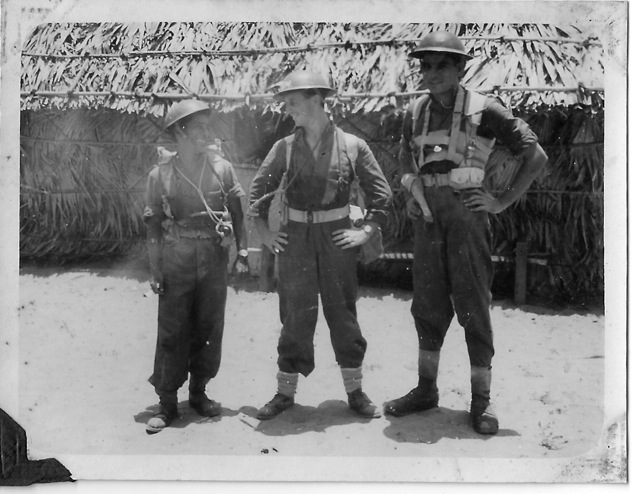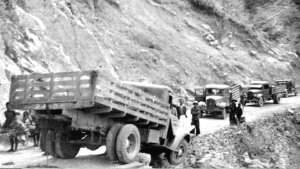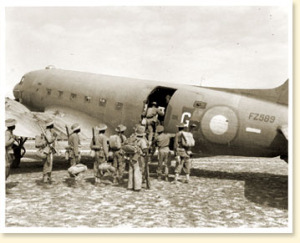Mandalay, March 1942

As the days went by, almost all my time began to be devoted to Air Evacuation problems which forced me to shift into Mandalay Town itself from the comfortable little cottage in Sagaing some 8 miles away.
An old friend placed a suite of rooms conveniently situated in the Bazar area at my disposal which I used both as office and living quarters. The friend also arranged for my meals which saved me both time and effort. There was a continuous flow of people wanting air passage and prepared to pay for it. However, I stuck to the norms agreed upon, and by and large, had little trouble enforcing the rules. My capacity to say ‘NO’ emphatically and without faltering was a handy tool in the circumstances though I did use my discretionary powers in order to help out deserving cases without bothering too much about adverse reaction from others.
I invariably managed to get well padded gentlemen to meet the passage money in return for an out of turn allocation of a seat going empty – as happened frequently, since families did not wish to be separated in those turbulent time. Here is an actual illustration: One fine morning a tall young man (6’4”) bounded into the Office grabbed me up and danced around the room in a gust of exuberance shouting ‘ho gaya, ho gaya’ as if he had won a lottery. It was Akram Khan, an old school friend who had gone into the Transport business and emerged a millionaire in the course of a year or so.

His lorries were operating on the Burma-China road on government contract and he had shifted lock, stock and barrel (which included the family, of course!) to Mandalay.
Himself a bachelor, he was anxious to evacuate his ailing mother and two sisters (18 & 20) by air to Calcutta. The sisters obviously did not qualify but I made a deal. He should pay for 10 seats and the three could go. He paid for 10 without batting an eye-lid and told me that he would be quite prepared to pay for any deserving case on my recommendation. By the time air-evacuation ended he had paid for more than 20 passages and I had no hesitation whatsoever in allocating an empty seat to him on the very last flight which left with 5 empty seats!

The Kyaw Htoons also decided to leave by air and I managed to accommodate the three of them on one flight. Mother left a couple of days later and this lifted a considerable load from my shoulders.
It was about this time that I persuaded the Agent to agree to our two ‘babus’ also leaving for India in a special aircraft which had landed at Shwebo with medicines. I kept back the Code Books to be destroyed before I hit the Road myself. All this left me completely free and I had only myself, my ruck sac and cycle to look after. I kept the cottage in Sagaing but was seldom able to use it. By the middle of March, the Japanese had already started consolidating their position in Rangoon and with the air-field under their command Toungoo and the smaller towns along the main Rangoon-Mandalay axis and the Irrawaddy came under constant attacks, and it became clear that all this activity was leading to a complete disruption of communication along the North-South axis with particular reference to Mandalay and Maymyo which had become the main staging centres for large Military and refugee columns making their way northwards – the former Via Myitkyina and the latter Via Tamu-Imphal. This also meant that all northern airfields would soon become targets for Japanese bombing attacks in order to deny them completely to the much reduced air component of the British Indian Forces as also to prevent them from being used for urgent supply and evacuation flights as was being done till then.
Our air evacuations scheme was being gradually wound down due to some uncertainty regarding aircraft availability, Japanese air activity in the area and a dramatic fall in demand for air tickets. The land evacuations, however, was in full swing though certainly not as smooth as could be wished.

Mandalay had become a seething mass of refugees from every entry point – north, south, east and west. Cholera had reached epidemic proportions and the hospitals and casualty stations choked with patients whilst thousands waited for admission.
As if this was not enough riots erupted in the heart of the town between Chinese and Burmese on one side and Indians on the other. This led to widespread arson, looting and murder and my estimate of casualties as reported to the Government of India was approximately 600 killed and over 3,000 injured. This cast a further strain on our infra-structural resources and be-devilled the atmosphere with an all-pervasive sense of suspicion, bitterness and hatred which had a seriously adverse effect on the administration of our evacuation programme where these two groups of communities stood at either end of the line; Indians as beneficiaries and Burmese etc. as controllers.
This sur-charged atmosphere resulted as we had feared in a ghastly tragedy at the Mandalay end of the Sagaing Bridge which by itself was estimated to have taken a toll of some 6,000 lives – men, women and children. Despite establishing control points in the shape of a police out-post at the Bridge-head only allowing entry to the bridge on the basis of what came to be known as the ‘Yellow Chit’ which originally had been devised to ensure that each refuge received his/her anti-cholera inoculation before being allowed to cross the bridge. This became a major weapon for fleecing the mostly illiterate refugees.
It came to our notice that up to Rs.3/= was being charged per individual by the Burmese Police and its Civil components. Considering over 20 lakh refugees are known to have crossed the bridge the total amount involved would have been a staggering 50 lakh or more which must have come as a windfall to a wide range of functionaries belonging to various units of the government – Police, Public health, PWD, etc. We were also worried at the thought of too many refugees being let loose on the road to Pakokku since there was little information available regarding the actual functional status of camps along the road and the ability of the camp staffs to cope with a viable level of efficiency with the sort of numbers which seemed almost astronomical at that stage. However, I soon got used to thinking about problems in those terms and this approach came in handy later when I became totally responsible for day-to-day planning of logistics and management of all Camps up to Tamu.

By the end of March 1942, Mandalay had been turned into a huge refugee camp with very little evidence left of its once reasonably efficient civic facilities.
Summer was setting in and the temperature had begun shooting up. The monsoon was almost a month away, but I was certainly not looking forward to it with its additional problems. The daily casualty figure (deaths) fluctuated between 100 – 300 and disposal of the corpses was posing a serious problem. In addition there was a constant depletion of medical and public health personnel, with substantial numbers deserting their posts and vanishing without trace. Some camps had neither doctor nor public-health staff and we were forced to conscript younger men and women (below 40) against permission to use camp facilities till the time came for them to hit the road. I spent 3 – 4 hours each morning (starting at 6 a.m.) going from Camp to Camp on my bicycle but made it a point of getting back to my ‘office’ by 11 a.m. by which time a horde of refugees would have collected outside (mostly well-to-do middle class men/women) wanting me to arrange special facilities for them e.g. bullock carts to carry them to Tamu, special rations, since they were not used to just rice and salt, requests to leave money and valuables (jewellery etc.) for safe-custody and delivery at some destination in India, arrangement for storage of household items (furniture, car, sewing machines etc.) at Mandalay or Maymyo for the duration of the Japanese occupation, transfer of important documents (leases, agreements, Loan receipts, Property ownership paper etc.) to India in my personal custody etc. etc. All in all it disclosed a level of selfishness, total unconcern for and ignorance of the tragedy and misery around them and the absolute conviction that the ability to pay conferred on them the right to expect such services as they required from someone like myself.
The on-going trauma of having to watch at close quarters and inevitably get involved in the tragedies resulting from whole families being wiped out in the course of a couple of days leaving behind young of all ages to be cared for, was a burden I had to carry right up to the time till I crossed into Manipur almost two months later, though not quite. The constant pressure imposed by other people’s misery and my own frustration had done my temper no good, and there were times when I could bear it no more and just lashed out in spasms of violent out breaks. All the same, however seemingly unreasonable, we did manage to help a fair number of people and I must confess that despite my rudeness and stupid out-breaks, I managed somehow to retain far more goodwill and consideration than I perhaps deserved.
There was the touching case of a young zerbadi couple from Moulmein in the far south who would wait patiently in my office for hours each day in the hope of being introduced to a compatible group for the long journey ahead to Tamu. I knew what was required and told them it would be done, but would take time. After a couple of days they realised I was not being able to get away for meals and quite unobtrusively took matters into their own hands. On the 3rd day as it approached 2 p.m. they suddenly stepped up to my desk and too charge. She firmly told all my visitors that I had to have my meal, cleared the desk of all papers and laid out a tiffin-carrier full of delicious Burmese dishes – my favourite. In the meantime, the husband sat down at another desk and noted down names and relevant details of my visitors till I had finished. It took me almost a week to find the right group for them to join – mostly young couples in the 30 – 40 age group. I am glad to say that they did eventually get to Calcutta but have no idea what happened to them later.
